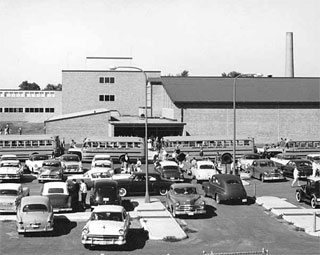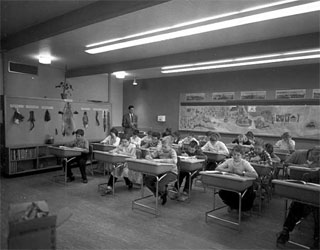Shirley Boeser: Thirteen New Schools!
The baby boom of the post-war years carried with it the burden of providing an education for a much larger student population than local communities had before the war. More classrooms were added to many existing schools, and new, larger and more modern schools cropped up all over the state of Minnesota. Shirley Boeser, whose family lived first in Richfield, and then in Bloomington during the 1950s, remembered when the latter suburb added an astonishing thirteen new schools to its district. She was interviewed in 2007 by Thomas Saylor.
TS: Go back to the 1950s when you were here. What kind of challenges did Richfield face, in your opinion, as a rapidly growing community with different types of people?
SB: I think one of the big challenges was the high school. There were 2,900 kids in Richfield High School at one time, and that’s too many.
TS: Yes. That’s a lot of kids. The high school opened in the mid-1950s. Suddenly...at least they have a high school [for the] kids. But during the 1950s, too, there were public elementary schools opening all the time and even then it was...
SB: I’m not sure about Richfield. I know in Bloomington - in 1961 we opened thirteen schools.
TS: In one year.
SB: In one year. New schools.
TS: Wow. That’s a whole district.
SB: Yes.
TS: All at once.
SB: And of course that has shrunk considerably. We sold a lot of buildings off out there. I just remember that one because...
TS: In Richfield, too. They didn’t sell them all off and now maybe they are glad they have a couple of these left because the numbers are starting to slowly go back up again.
SB: Yes. A little.
TS: But of course the 1950s and ‘60s boom became the 1970s and ‘80s with a decline in population for the schools.
Mrs. Boeser's children attended Assumption Catholic School in Richfield, which was located across the freeway from the family's home. The Boesers joined with other local families to petition for a solution for getting the children safely to school.
SB: Then my kids had to walk to Assumption School. So we petitioned for a walkway across that freeway. Because that was much too dangerous a freeway then to go and walk across.
TS: Heavens, yes.
SB: So we did get our walkway. Because it was a big school. It had anywhere from a thousand to twelve hundred kids at different times.
TS: Just amazing. I mean, to think that the school has grown from - in the 1930s - from really almost a village school with not many kids, and exploded to really envelope a lot of the suburban growth.
Source
Boeser, Shirley; Thomas Saylor, Interviewer, Richfield Oral History Project, Minnesota Historical Society Oral History Collection, 2007.





